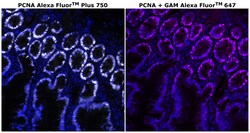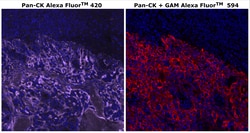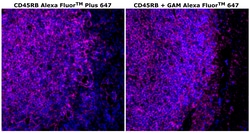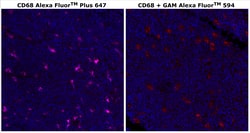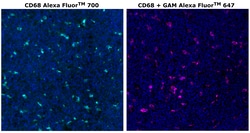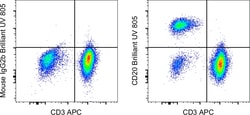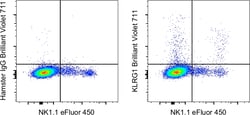
Antibodies
Antibodies are glycoproteins that serve an essential role in the immune system to protects animals from infection, or the cytotoxic effects of foreign compounds, by binding with high affinity to invasive molecules; classified as primary or secondary.

Primary Antibodies
(131,885)

Secondary Antibodies
(2,371)

Isotype Controls and Standards
(623)

Antibody Panels and Kits
(60)
Filtered Search Results
Products from some of our suppliers do not display in filtered search results. Please
clear all filters
to see these products.
1
–
15
of
126,218
results
| Content And Storage | Store at 4°C short term. For long term storage, store at -20°C, avoiding freeze/thaw cycles. |
|---|---|
| Target Species | Human |
| Host Species | Rabbit |
| Conjugate | Unconjugated |
| Applications | Immunocytochemistry,Western Blot |
| Form | Liquid |
| Gene Accession No. | P68431, Q71DI3 |
| Isotype | IgG |
| Concentration | 0.5 mg/mL |
| Antigen | H3K27me2 |
| Gene Symbols | H3C1, H3C10, H3C12, H3C14, H3C15, H3C2, H3C7 |
| Regulatory Status | RUO |
| Purification Method | Affinity Chromatography |
| Gene Alias | dimethyl H3; di-methyl H3; Dimethyl Histone H3; di-methyl histone H3; Di-Methyl-H3 K27; Di-Methyl-H3 Lys27; Di-Methyl-Histone H3 K27; Di-Methyl-Histone H3 Lys27; Di-Tri-Methyl-Histone H3 K27; Di-Tri-Methyl-Histone H3 Lys27; H3; H3 histone; H3 histone family, member A; H3 histone family, member I; H3 histone family, member K; H3 histone family, member L; H3 histone family, member M; H3 histone, family 2; H3 histone, family 3A; H3 histone, family 3B; H3 histone, family 3B (H3.3B); H3 histone, family 3B.1; H3 histone, family 3C; H3 K27me2; H3.1-221; H3.1-291; H3.1-I; H3.2; H3.2-221; H3.2-614; H3.2-615; H3.2-616; H3.3A; H3.3B; H3.5; H3/A; H3/b; H3/d; H3/f; H3/i; H3/j; H3/k; H3/l; H3/M; H3/n; H3/o; H3-143; H3-291; H3-3A; H3-3B; h3-5; H3-53; H3-614; H3a; H3b; H3-B; H3C1; H3c10; H3c11; H3C12; H3C2; H3C3; H3C4; H3C6; H3C7; H3C8; H3f; H3-F; H3F1K; H3F2; H3F3; h3f3a; H3F3B; h3f3b.1; h3f3c; h3f3d; H3FA; H3FB; H3FC HIST1H3C; H3FD; H3FF; H3FH; H3FI; H3FJ; H3FK; H3FL; H3FM; H3FN; H3g; H3h; H3i; H3k27; H3K27me2/3; H3K27me2me3; H3Lys27me2; H3Lys27me2/3; H3Lys27me2me3; Hist1; HIST1H3A; HIST1H3B; Hist1h3c; HIST1H3D; Hist1h3e; HIST1H3F; Hist1h3g; HIST1H3H; HIST1H3I; HIST1H3J; HIST2H3A; Hist2h3b; HIST2H3C; Hist2h3c1; Hist2h3c2; Hist2h3c2-ps; Hist2h3ca1; Hist2h3ca2; HIST2H3D; histone 1, H3a; histone 1, H3b; histone 1, H3f; histone 1, H3h; histone 2, H3a; histone 2, H3c; histone 2, H3c2; histone 2, H3ca2; Histone 3; histone cluster 1, H3a; histone cluster 1, H3b; histone cluster 1, H3f; histone cluster 1, H3h; histone cluster 2, H3a; histone cluster 2, H3c; histone cluster 2, H3c2; histone cluster 2, H3c2, pseudogene; histone gene complex 1; histone H3; histone H3.1; Histone H3.2; histone H3.3; Histone H3.3C; histone H3.5; Histone H3/a; Histone H3/b; Histone H3/c; Histone H3/d; Histone H3/f; Histone H3/h; Histone H3/i; Histone H3/j; Histone H3/k; histone H3/l; Histone H3/m; histone H3/o; Histone H3K27; Histone H3K27me2; histone variant H3.5; hypothetical protein LOC550262; M32461; methyl Histone 3; methyl Histone H3; PP781; wu:fa25h06; wu:fa96g06; wu:fb07a08; wu:fb36f01; zgc:110292; zgc:174300; zgc:56193; zgc:56418; zgc:64222; zgc:86731 |
| Gene | H3C15 |
| Product Type | Antibody |
| Gene ID (Entrez) | 126961, 333932, 8350, 8356, 8357, 8358, 8968 |
| Formulation | PBS with 0.1% BSA, 30% glycerol and 0.09% sodium azide; pH 7.2 |
| Immunogen | Peptide corresponding to Human HIST1H3A (aa 24-31). |
| Classification | Polyclonal |
| Primary or Secondary | Primary |
| Content And Storage | 4°C, store in dark |
|---|---|
| Target Species | Human |
| Host Species | Mouse |
| Conjugate | Alexa Fluor Plus 750 |
| Applications | Immunohistochemistry (Paraffin) |
| Form | Liquid |
| Gene Accession No. | P12004 |
| Isotype | IgG2a |
| Concentration | 0.2 mg/mL |
| Antigen | PCNA |
| Gene Symbols | Pcna |
| Regulatory Status | RUO |
| Purification Method | Purified |
| Gene Alias | ATLD2; cb16; Cyclin; DNA polymerase delta auxiliary protein; etID36690.10; fa28e03; fb36g03; HGCN8729; hypothetical protein LOC515499; MGC8367; Pcna; pcna protein; Pcna/cyclin; PCNAR; POL30; Proliferating cell nuclear antigen; wu:fa28e03; wu:fb36g03; YBR0811; YBR088C |
| Gene | Pcna |
| Product Type | Antibody |
| Gene ID (Entrez) | 5111 |
| Formulation | PBS with 0.5% BSA, 10% proprietary stabilizer and 0.05% sodium azide; pH 7.2 |
| Immunogen | Rat recombinant PCNA polypeptides. |
| Classification | Monoclonal |
| Primary or Secondary | Primary |
| Clone | PC10 |
| Content And Storage | 4°C, store in dark |
|---|---|
| Target Species | Human |
| Host Species | Mouse |
| Conjugate | Alexa Fluor 420 |
| Applications | Immunohistochemistry (Paraffin) |
| Form | Liquid |
| Gene Accession No. | P02533, P02538, P04264, P05783, P05787, P08727, P08729, P08779, P12035, P13645, P13646, P13647, P19012, P19013, P35908, Q01546, Q04695, Q7Z794 |
| Isotype | IgG1 |
| Concentration | 0.2 mg/mL |
| Antigen | Cytokeratin Pan Type I/II |
| Gene Symbols | KRT1, KRT10, KRT13, KRT14, KRT15, KRT16, KRT17, KRT18, KRT19, KRT2, KRT3, KRT4, KRT5, Krt6a, KRT7, KRT76, KRT77, KRT8 |
| Regulatory Status | RUO |
| Purification Method | Affinity chromatography |
| Gene Alias | 2310016L08Rik; 3300001P10Rik; 39.1; 40-kDa keratin intermediate filament; 47 kDa cytokeratin; 56 kDa cytokeratin; 57kd keratin; 57kDa keratin; 58 kDa cytokeratin; 60-kDa keratin; 63kDa Keratin; 65 kDa cytokeratin; 67 kDa cytokeratin; AA960620; adult keratin; AI324768; AI528832; AI626930; AI663979; AL022697; alpha keratin; AU019895; AW108092; AW146334; basic epidermal type II cytokeratin (carboxy-terminal region, clone pUF164); BB005427; BCIE; BIE; Card2; cell proliferation-inducing gene 46 protein; CK 2e; CK1; CK-1; CK10; CK-10; CK13; CK-13; CK14; CK-14; CK15; CK-15; CK16; CK-16; CK-17; CK18; CK-18; CK19; CK-19; CK-1B; CK-2e; CK3; CK-3; CK4; CK-4; CK5; CK-5; ck55; CK6A; CK-6A; CK6C; CK-6C; CK6D; CK-6D; CK-6E; CK7; CK-7; CK8; CK-8; CYK18; CYK4; CYK8; CYKER; cytokeratin 1; cytokeratin 10; cytokeratin 13; cytokeratin 14; cytokeratin 15; cytokeratin 16; cytokeratin 18; cytokeratin 19; cytokeratin 3; cytokeratin 4; cytokeratin 5; cytokeratin 6A; cytokeratin 6C; cytokeratin 6D; cytokeratin 7; cytokeratin 8; cytokeratin 8 (370 AA); cytokeratin endo A; Cytokeratin endo B; cytokeratin otokeratin; cytokeratin type II; cytokeratin type II, component Ib/c; cytokeratin type II, component III; cytokeratin VIB; cytokeratin VII; cytokeratin-1; Cytokeratin-10; cytokeratin-13; Cytokeratin-14; cytokeratin-15; Cytokeratin-16; cytokeratin-17; Cytokeratin-18; cytokeratin-19; Cytokeratin-1B; Cytokeratin-2e; cytokeratin-3; Cytokeratin-4; cytokeratin-5; Cytokeratin-6A; cytokeratin-6B; cytokeratin-6C; Cytokeratin-6D; cytokeratin-6E; cytokeratin-7; Cytokeratin-8; cytokeratin-A; Cytoskeletal 57 kDa keratin; D130054E02Rik; D15Wsu77e; DDD; DDD1; ear specific cytokeratin; EBS2; ebs3; ebs4; EGK_03684; EGK_03685; EHK; EHK1; Endo B; EndoA; EndoC; epidermal keratin 10; epidermal keratin VII; epidermolysis bullosa simplex 2 Dowling-Meara/Kobner/Weber-Cockayne types; epidermolysis bullosa simplex, Dowling-Meara, Koebner; epidermolytic hyperkeratosis 1; epidermolytic hyperkeratosis; keratosis palmaris et plantaris; epithelial keratin 1; epithelial keratin 10; epithelial keratin 2e; Epithelial keratin-1; Epithelial keratin-2e; EPPK; fgk; fin and gill keratin; FNEPPK; focal non-epidermolytic palmoplantar keratoderma; GK-19; Hair alpha protein; HMWCK; Hom s 5; I79_019823; I79_021074; I79_023185; I79_024335; intermediate filament protein; K1; K10; K13; K14; K15; K16; K17; K18; K19; K1B; K1C1; K1CO; K1CP; K1CS; K2C7; K2C8; K2e; K3; K3 keratin; K4; K5; K6A; K6a keratin; K6C; K6D; K7; K77; K8; Ka10; Ka13; Ka14; Ka15; Ka16; Ka17; Ka19; kamp-keratin derived antimicrobial peptide; Kb1; Kb2; Kb4; Kb7; KDAMP; KER1; Ker10; Ker2; KERA; keratin; keratin 1; keratin 1 (epidermolytic hyperkeratosis); keratin 1, type II; keratin 10; keratin 10 (epidermolytic hyperkeratosis); keratin 10 (epidermolytic hyperkeratosis; keratosis palmaris et plantaris); keratin 10, type I; keratin 10, type I L homeolog; keratin 10, type I S homeolog; keratin 12, gene 2 S homeolog; keratin 13; keratin 13, type I; keratin 13, type I S homeolog; keratin 14; keratin 14 (epidermolysis bullosa simplex, Dowling-Meara, Koebner); keratin 14, type I; keratin 14, type I L homeolog; keratin 15; keratin 15, gene 1 S homeolog; keratin 15, type I; keratin 16; keratin 16 (focal non-epidermolytic palmoplantar keratoderma); keratin 16, type I; keratin 16, type I S homeolog; keratin 17; keratin 17 L homeolog; keratin 17, type I; keratin 17, type I L homeolog; keratin 18; keratin 18, type I; keratin 19; keratin 19 S homeolog; keratin 19 S homeolog; keratin 19; keratin 19, type I; Keratin 1B; keratin 2; keratin 2 (epidermal ichthyosis bullosa of Siemens); keratin 2 epidermis; keratin 2, type II; keratin 24; keratin 2A; keratin 2A (epidermal ichthyosis bullosa of Siemens); keratin 3; keratin 3, type II; keratin 4; keratin 4, type II; keratin 5; keratin 5 (epidermolysis bullosa simplex Dowling-Meara/Kobner/Weber-Cockayne types); keratin 5 (epidermolysis bullosa simplex, Dowling-Meara/Kobner/Weber-Cockayne types) |
| Gene | KRT16 |
| Product Type | Antibody |
| Gene ID (Entrez) | 374454, 3848, 3849, 3850, 3851, 3852, 3853, 3855, 3856, 3858, 3860, 3861, 3866, 3868, 3872, 3875, 3880, 51350 |
| Formulation | PBS with 0.5% BSA, 10% proprietary stabilizer and 0.05% sodium azide; pH 7.2 |
| Immunogen | Human epidermal keratin. |
| Classification | Cocktail |
| Primary or Secondary | Primary |
| Clone | AE1/AE3 |
CD45RB Monoclonal Antibody (PD7/26), Alexa Fluor™ Plus 647
CD45RB Monoclonal Antibody (PD7/26), Alexa Fluor™ Plus 647
| Content And Storage | 4°C, store in dark |
|---|---|
| Target Species | Human |
| Host Species | Mouse |
| Conjugate | Alexa Fluor Plus 647 |
| Applications | Immunohistochemistry (Paraffin) |
| Form | Liquid |
| Gene Accession No. | P34810 |
| Isotype | IgG1 κ |
| Concentration | 0.2 mg/mL |
| Antigen | CD68 |
| Gene Symbols | Cd68 |
| Regulatory Status | RUO |
| Purification Method | Affinity Chromatography |
| Gene Alias | CD68; CD68 antigen; CD68 molecule; GP110; Lamp4; macrophage antigen CD68; macrosialin; Scard1; scavenger receptor class D, member 1; similar to CD68 antigen |
| Gene | Cd68 |
| Product Type | Antibody |
| Gene ID (Entrez) | 968 |
| Formulation | PBS with 0.5% BSA, 10% Proprietary stabilizer and 0.05% sodium azide; pH 7.2 |
| Classification | Monoclonal |
| Primary or Secondary | Primary |
| Clone | KP1 |
Alpha-Smooth Muscle Actin Monoclonal Antibody (1A4), Alexa Fluor™ 420
Alpha-Smooth Muscle Actin Monoclonal Antibody (1A4), Alexa Fluor™ 420
| Content And Storage | 4°C, store in dark |
|---|---|
| Target Species | Human |
| Host Species | Mouse |
| Conjugate | Alexa Fluor 700 |
| Applications | Immunohistochemistry (Paraffin) |
| Form | Liquid |
| Gene Accession No. | P34810 |
| Isotype | IgG1 κ |
| Concentration | 0.2 mg/mL |
| Antigen | CD68 |
| Gene Symbols | Cd68 |
| Regulatory Status | RUO |
| Purification Method | Affinity chromatography |
| Gene Alias | CD68; CD68 antigen; CD68 molecule; GP110; Lamp4; macrophage antigen CD68; macrosialin; Scard1; scavenger receptor class D, member 1; similar to CD68 antigen |
| Gene | Cd68 |
| Product Type | Antibody |
| Gene ID (Entrez) | 968 |
| Formulation | PBS with 0.5% BSA, 10% proprietary stabilizer and 0.05% sodium azide; pH 7.2 |
| Classification | Monoclonal |
| Primary or Secondary | Primary |
| Clone | KP1 |
CD20 Monoclonal Antibody (2H7), Brilliant Ultra Violet™ 805, eBioscience™, Invitrogen™
Mouse Monoclonal Antibody
| Content And Storage | 4°C, store in dark, DO NOT FREEZE! |
|---|---|
| Target Species | Human |
| Host Species | Mouse |
| Conjugate | Brilliant Ultraviolet 805 |
| Applications | Flow Cytometry |
| Form | Liquid |
| Isotype | IgG2b κ |
| Gene Accession No. | P11836 |
| Concentration | 5 μL/Test |
| Antigen | CD20 |
| Regulatory Status | RUO |
| Purification Method | Affinity chromatography |
| Gene Alias | AA960661; APY; ATOPY; B1; B-cell differentiation antigen Ly-44; B-lymphocyte antigen CD20; B-lymphocyte cell-surface antigen B1; B-lymphocyte surface antigen B1; Bp35; Cd20; CD20 antigen; CD20 cell surface protein; CD20 receptor; CVID5; EGK_06167; Fc epsilon receptor I beta chain; Fc Fragment of IgE high affinity I receptor for beta polypeptide; FCER1B; High affinity immunoglobulin epsilon receptor subunit beta; IgE Fc receptor subunit beta; IGEL; IGER; IGHER; LEU16; LEU-16; Leukocyte surface antigen Leu-16; Ly44; Ly-44; Lymphocyte antigen 44; membrane spanning 4-domains A1; membrane-spanning 4-domains subfamily A member 1; membrane-spanning 4-domains, subfamily A, member 1; membrane-spanning 4-domains, subfamily A, member 2; MGC3969; MS4A1; MS4A2; S7 |
| Gene | Ms4a1 |
| Product Type | Antibody |
| Gene ID (Entrez) | 931 |
| Formulation | PBS with BSA and 0.09% sodium azide; pH 7.2 |
| Classification | Monoclonal |
| Primary or Secondary | Primary |
| Clone | 2H7 |
CD40 Monoclonal Antibody (1C10), Brilliant Ultra Violet™ 661, eBioscience™, Invitrogen™
Rat Monoclonal Antibody
| Content And Storage | 4°C, store in dark, DO NOT FREEZE! |
|---|---|
| Target Species | Mouse |
| Host Species | Rat |
| Conjugate | Brilliant Ultraviolet 661 |
| Applications | Flow Cytometry |
| Form | Liquid |
| Isotype | IgG2a κ |
| Gene Accession No. | P27512 |
| Concentration | 0.2 mg/mL |
| Antigen | CD40 |
| Regulatory Status | RUO |
| Purification Method | Affinity chromatography |
| Gene Alias | AI326936; B cell surface antigen CD40; B cell-associated molecule; B-cell surface antigen CD40; Bp50; CD antigen CD40; Cd40; CD40 antigen; CD40 antigen (TNF receptor superfamily member 5); CD40 antigen, TNF receptor superfamily member 5; CD40 molecule; CD40 molecule, TNF receptor superfamily member 5; CD40L receptor; CDw40; GP39; HIGM1; I79_006806; IGM; IMD3; Immunoglobulin M; ImmunoglobulinM; membrane protein CD40; MGC9013; p50; receptor for ligand CD154; sCD40; soluble CD40; T-BAM; T-cell differentiation antigen; Tnfrsf5; TRAP; tumor necrosis factor receptor superfamily member 5; tumor necrosis factor receptor superfamily, member 5 |
| Gene | CD40 |
| Product Type | Antibody |
| Gene ID (Entrez) | 21939 |
| Formulation | PBS with BSA and 0.09% sodium azide; pH 7.2 |
| Classification | Monoclonal |
| Primary or Secondary | Primary |
| Clone | 1C10 |
Syrian Hamster IgG Isotype Control, Brilliant Violet™ 605, eBioscience™, Invitrogen™
Syrian Hamster Polyclonal Antibody
| Content And Storage | 4° C, store in dark, DO NOT FREEZE! |
|---|---|
| Target Species | Not Applicable |
| Host Species | Syrian Hamster |
| Conjugate | Brilliant Violet 605 |
| Applications | Control,Flow Cytometry |
| Form | Liquid |
| Isotype | IgG |
| Concentration | 0.2 mg/mL |
| Antigen | Syrian Hamster IgG |
| Regulatory Status | RUO |
| Purification Method | Affinity chromatography |
| Gene Alias | IgG; Immunoglobulin G; ImmunoglobulinG |
| Formulation | PBS with BSA and 0.09% sodium azide; pH 7.2 |
| Classification | Polyclonal |
IL-33R (ST2) Monoclonal Antibody (hIL33Rcap), Brilliant Violet™ 421, eBioscience™, Invitrogen™
Mouse Monoclonal Antibody
| Content And Storage | 4°C, store in dark, DO NOT FREEZE! |
|---|---|
| Target Species | Human |
| Host Species | Mouse |
| Conjugate | Brilliant Violet 421 |
| Applications | Flow Cytometry |
| Form | Liquid |
| Isotype | IgG1 κ |
| Gene Accession No. | Q01638 |
| Concentration | 5 μL/Test |
| Antigen | IL-33R (ST2) |
| Regulatory Status | RUO |
| Purification Method | Affinity chromatography |
| Gene Alias | DER4; Fit1; Fit-1; Fos-responsive gene 1 protein; growth stimulation-expressed; homolog of mouse growth stimulation-expressed; IL-1 R4; IL1RL1; IL-1RL1; IL33R; IL-33R; interleukin 1 receptor like 1; interleukin 1 receptor-like 1; interleukin 1 receptor-related protein; Interleukin1 receptor like 1; interleukin-1 receptor-like 1; Interleukin-33 receptor alpha chain; Ly84; lymphocyte antigen 84; Protein ST2; Protein T1; sIL 33R; soluble IL 33 Receptor; soluble IL 33R; St2; ST2L; St2-rs1; ST2V; Ste2; T1; T1/ST2 |
| Gene | IL1RL1 |
| Product Type | Antibody |
| Gene ID (Entrez) | 9173 |
| Formulation | PBS with BSA and 0.09% sodium azide; pH 7.2 |
| Immunogen | Extracellular domain of human IL-33R protein. |
| Classification | Monoclonal |
| Primary or Secondary | Primary |
| Clone | hIL33Rcap |
CD40 Monoclonal Antibody (1C10), Brilliant Violet™ 605, eBioscience™, Invitrogen™
Rat Monoclonal Antibody
| Content And Storage | 4°C, store in dark, DO NOT FREEZE! |
|---|---|
| Target Species | Mouse |
| Host Species | Rat |
| Conjugate | Brilliant Violet 605 |
| Applications | Flow Cytometry |
| Form | Liquid |
| Isotype | IgG2a κ |
| Gene Accession No. | P27512 |
| Concentration | 0.2 mg/mL |
| Antigen | CD40 |
| Regulatory Status | RUO |
| Purification Method | Affinity chromatography |
| Gene Alias | AI326936; B cell surface antigen CD40; B cell-associated molecule; B-cell surface antigen CD40; Bp50; CD antigen CD40; Cd40; CD40 antigen; CD40 antigen (TNF receptor superfamily member 5); CD40 antigen, TNF receptor superfamily member 5; CD40 molecule; CD40 molecule, TNF receptor superfamily member 5; CD40L receptor; CDw40; GP39; HIGM1; I79_006806; IGM; IMD3; Immunoglobulin M; ImmunoglobulinM; membrane protein CD40; MGC9013; p50; receptor for ligand CD154; sCD40; soluble CD40; T-BAM; T-cell differentiation antigen; Tnfrsf5; TRAP; tumor necrosis factor receptor superfamily member 5; tumor necrosis factor receptor superfamily, member 5 |
| Gene | CD40 |
| Product Type | Antibody |
| Gene ID (Entrez) | 21939 |
| Formulation | PBS with BSA and 0.09% sodium azide; pH 7.2 |
| Classification | Monoclonal |
| Primary or Secondary | Primary |
| Clone | 1C10 |
KLRG1 Monoclonal Antibody (2F1), Brilliant Violet™ 605, eBioscience™, Invitrogen™
Syrian Hamster Monoclonal Antibody
| Content And Storage | 4°C, store in dark, DO NOT FREEZE! |
|---|---|
| Target Species | Mouse |
| Host Species | Syrian Hamster |
| Conjugate | Brilliant Violet 605 |
| Applications | Flow Cytometry |
| Form | Liquid |
| Isotype | IgG |
| Gene Accession No. | O88713 |
| Concentration | 0.2 mg/mL |
| Antigen | KLRG1 |
| Regulatory Status | RUO |
| Purification Method | Affinity chromatography |
| Gene Alias | 2F1; 2F1-Ag; CLEC15A; C-type lectin domain family 15 member A; C-type lectin domain family 15, member A; ITIM-containing receptor MAFA-L; killer cell lectin like receptor G1; killer cell lectin-like receptor subfamily G member 1; killer cell lectin-like receptor subfamily G, member 1; Klrg1; Mafa; MAFA-2F1; MAFAL; MAFA-L; MAFA-LIKE; MAFA-like receptor; Mast cell function-associated antigen; mast cell function-associated antigen (ITIM-containing); mast cell function-associated antigen 2F1; natural killer cell receptor |
| Gene | Klrg1 |
| Product Type | Antibody |
| Gene ID (Entrez) | 50928 |
| Formulation | PBS with BSA and 0.09% sodium azide; pH 7.2 |
| Classification | Monoclonal |
| Primary or Secondary | Primary |
| Clone | 2F1 |
KLRG1 Monoclonal Antibody (2F1), Brilliant Violet™ 711, eBioscience™, Invitrogen™
Syrian Hamster Monoclonal Antibody
| Content And Storage | 4°C, store in dark, DO NOT FREEZE! |
|---|---|
| Target Species | Mouse |
| Host Species | Syrian Hamster |
| Conjugate | Brilliant Violet 711 |
| Applications | Flow Cytometry |
| Form | Liquid |
| Isotype | IgG |
| Gene Accession No. | O88713 |
| Concentration | 0.2 mg/mL |
| Antigen | KLRG1 |
| Regulatory Status | RUO |
| Purification Method | Affinity Chromatography |
| Gene Alias | 2F1; 2F1-Ag; CLEC15A; C-type lectin domain family 15 member A; C-type lectin domain family 15, member A; ITIM-containing receptor MAFA-L; killer cell lectin like receptor G1; killer cell lectin-like receptor subfamily G member 1; killer cell lectin-like receptor subfamily G, member 1; Klrg1; Mafa; MAFA-2F1; MAFAL; MAFA-L; MAFA-LIKE; MAFA-like receptor; Mast cell function-associated antigen; mast cell function-associated antigen (ITIM-containing); mast cell function-associated antigen 2F1; natural killer cell receptor |
| Gene | Klrg1 |
| Product Type | Antibody |
| Gene ID (Entrez) | 50928 |
| Formulation | PBS with BSA and 0.09% sodium azide; pH 7.2 |
| Classification | Monoclonal |
| Primary or Secondary | Primary |
| Clone | 2F1 |
CD20 Monoclonal Antibody (2H7), Brilliant Ultra Violet™ 395, eBioscience™, Invitrogen™
Mouse Monoclonal Antibody
| Content And Storage | 4°C, store in dark, DO NOT FREEZE! |
|---|---|
| Target Species | Human |
| Host Species | Mouse |
| Conjugate | Brilliant Ultraviolet 395 |
| Applications | Flow Cytometry |
| Form | Liquid |
| Isotype | IgG2b κ |
| Gene Accession No. | P11836 |
| Concentration | 5 μL/Test |
| Antigen | CD20 |
| Regulatory Status | RUO |
| Purification Method | Affinity chromatography |
| Gene Alias | AA960661; APY; ATOPY; B1; B-cell differentiation antigen Ly-44; B-lymphocyte antigen CD20; B-lymphocyte cell-surface antigen B1; B-lymphocyte surface antigen B1; Bp35; Cd20; CD20 antigen; CD20 cell surface protein; CD20 receptor; CVID5; EGK_06167; Fc epsilon receptor I beta chain; Fc Fragment of IgE high affinity I receptor for beta polypeptide; FCER1B; High affinity immunoglobulin epsilon receptor subunit beta; IgE Fc receptor subunit beta; IGEL; IGER; IGHER; LEU16; LEU-16; Leukocyte surface antigen Leu-16; Ly44; Ly-44; Lymphocyte antigen 44; membrane spanning 4-domains A1; membrane-spanning 4-domains subfamily A member 1; membrane-spanning 4-domains, subfamily A, member 1; membrane-spanning 4-domains, subfamily A, member 2; MGC3969; MS4A1; MS4A2; S7 |
| Gene | Ms4a1 |
| Product Type | Antibody |
| Gene ID (Entrez) | 931 |
| Formulation | PBS with BSA and 0.09% sodium azide; pH 7.2 |
| Classification | Monoclonal |
| Primary or Secondary | Primary |
| Clone | 2H7 |

